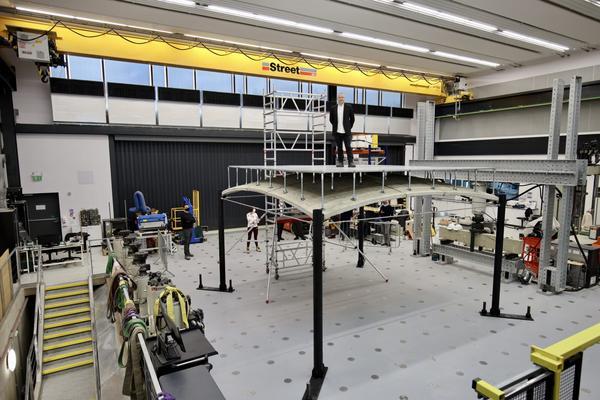University research team redesigns shape of floors to cut concrete usage
A new vaulted style of floor uses 75% less concrete than a traditional flat slab floor and could help the construction industry reduce its carbon footprint, according to an interdisciplinary team of structural engineers, mathematicians and manufacturing experts from the universities of Bath, Cambridge and Dundee.
A 4.5m x 4.5m full-scale demonstration of a thin-shell floor, which the team says uses 60% less carbon in its construction than an equivalent flat slab that could carry the same load, has been set up in the NRFIS laboratory at Cambridge University's civil engineering department. The curved vault-shaped structure is covered by standard raised floor panels to create a level surface.

Dr Paul Shepherd of the ACORN team shows off the prototype thin-shell floor
Created by the UKRI-funded ACORN (Automating Concrete Construction) research project, the vault-shaped floor design takes advantage of concrete's inherent natural properties and strengths.
Dr Paul Shepherd, a Reader in Bath's Department of Architecture & Civil Engineering and the Principal Investigator for ACORN, says: "Achieving the net-zero targets recently ratified at the COP26 conference will require significant change by the construction industry, which is responsible for about half of the UK's total emissions. Since concrete is the world's most widely consumed material after water, and its production contributes more than 7% of global CO2 emissions, the easiest way for construction to begin its journey to net-zero is to use less concrete.
"That has been the driving force behind this project, which we hope could make a major difference to the impact of construction."
Currently, most building floors use thick flat slabs of solid concrete, which rely on lots of steel reinforcement to allow them to resist tension. ACORN's approach is to use concrete for what it is good at – resisting compression.
The ACORN team say by putting the material only where it is needed, and making sure it works in compression, their design uses far less concrete. The team has in parallel developed an automated adaptable mould and a robotic concrete spraying system that can be used in an off-site factory setting, as the new shape may prove impractical to make using traditional temporary formwork.
Alongside this new style of fabrication, the team has also developed bespoke software to seamlessly optimise floors for a given building design, and control the automated manufacturing system to produce them.
As the floor is made off-site, it also needs to be transported to site and assembled. The team had to split the large floor into nine transportable pieces and develop a connection system to join the pieces together.
Reversible joints have been incorporated so that the floor can be disassembled and reused elsewhere at the end of the building's life.
Each piece took only half an hour to make, and the whole floor took a week to assemble – future commercial versions could be manufactured in dedicated industrial facilities much more quickly, ACORN said.
Dr Shepherd adds: "After three years of research it is amazing to see the fruits of all our hard work dominating the laboratory and drawing interested looks from all who passed by. It's not every day you can jump on top of your research! I just hope that one day soon this type of low-carbon automatically manufactured building becomes so widespread that people walk by without noticing."
ACORN has received funding from UK Research and Innovation under the ISCF Transforming Construction programme.






